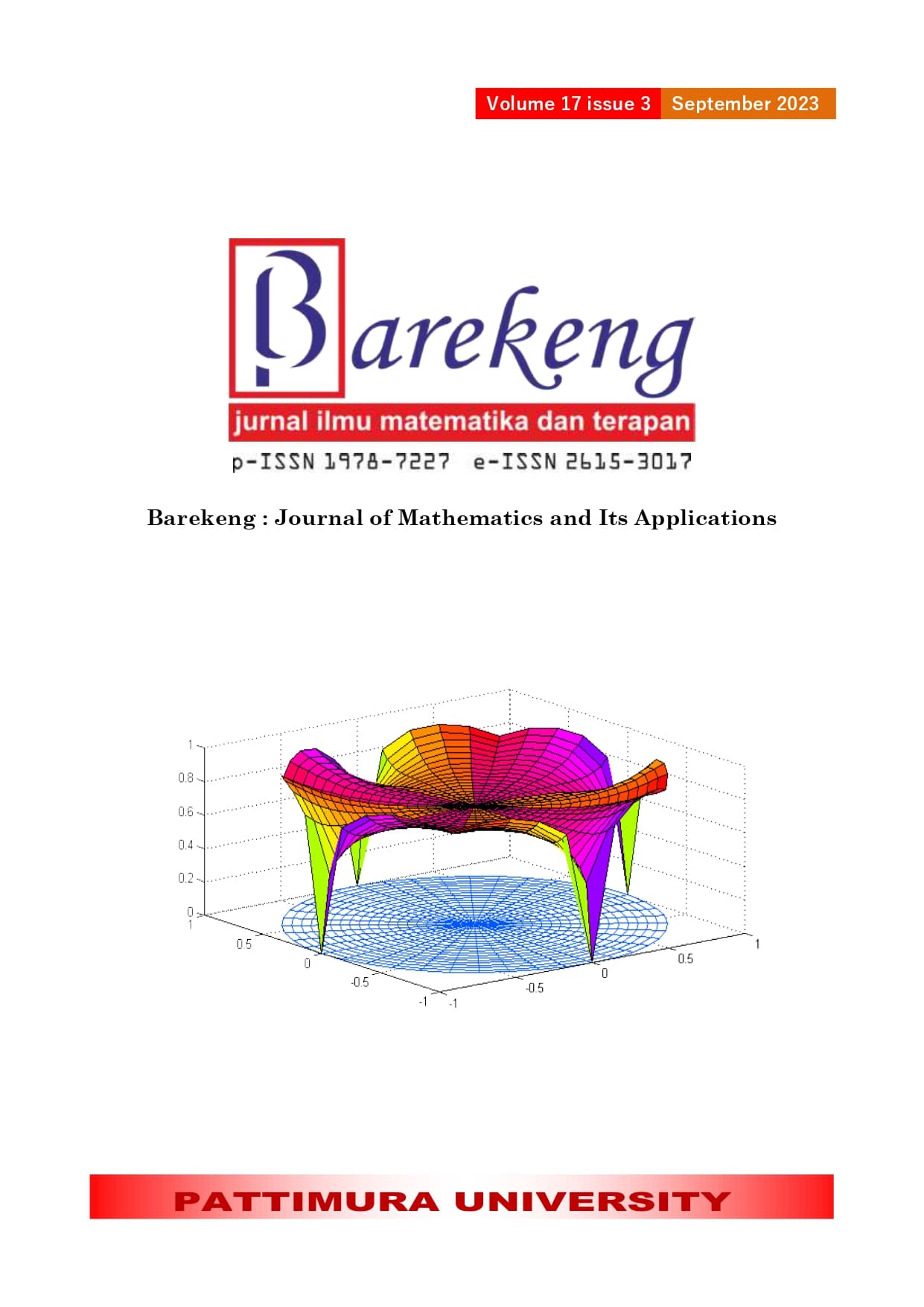FUZZY TIME SERIES BASED ON THE HYBRID OF FCM WITH CMBO OPTIMIZATION TECHNIQUE FOR HIGH WATER PREDICTION
Abstract
Time series data represents measurements taken over a specific period and is often employed for forecasting purposes. The typical approach in forecasting involves the analysis of relationships among estimated variables.In this study, we apply Fuzzy Time Series (FTS) to water level data collected every 10 minutes at the Irish Achill Island Observation Station. The FTS, which is based on Fuzzy C-Means (FCM), is hybridized with the Cat and Mouse Based Optimizer (CMBO). This hybridization of FCM with the CMBO optimizer aims to address weaknesses inherent in FTS, particularly concerning the determination of interval lengths, with the ultimate goal of enhancing prediction accuracy.Before conducting forecasts, we execute the FCM-CMBO process to determine the optimal centroid used for defining interval lengths within the FTS framework. Our study utilizes a dataset comprising 52,562 data points, obtained from the official Kaggle website. Subsequently, we assess forecasting accuracy using the Mean Absolute Percent Error (MAPE), where a smaller percentage indicates superior performance. Our proposed methodology effectively mitigates the limitations associated with interval length determination and significantly improves forecasting accuracy. Specifically, the MAPE percentage for FTS-FCM before optimization is 20.180%, while that of FCM-CMBO is notably lower at 18.265%. These results highlight the superior performance of the FCM-CMBO hybrid approach, which achieves a forecasting accuracy of 81.735% when compared to actual data.
Downloads
References
M. Makridakis, Wheelwright., Metode dan Aplikasi Peramalan. Jakarta: Binarupa Aksara, 1999.
Y. Safitri, S. Wahyuningsih, and R. Goejantoro, “Peramalan dengan Metode Fuzzy Time Series Markov Chain ( Studi Kasus : Harga Penutupan Saham PT . Radiant Utama Interinsco Tbk Periode Januari 2011 – Maret 2017 ) Forecasting with Fuzzy Time Series Markov Chain Method ( Case Study : Closing Stock Price of,” J. Eksponensial, vol. 9, no. 1, pp. 51–58, 2018.
J. . Bezdek, Pattern Recognition with Fuzzy Objective Function Algorithms. New York: Plenum, 1981.
M. Bose and K. Mali, "Designing Fuzzy Time Series Forecasting Models: A Survey," Int. J. Approx. Reason., pp. 78–79, 2019.
N. Van Tinh, “Enhanced Forecasting Accuracy of Fuzzy Time Series Model Based on Combined Fuzzy C-Mean Clustering with Particle Swam Optimization,” Int. J. Comput. Intell. Appl., vol. 19, no. 2, 2020.
W. Zhang, S. Zhang, S. Zhang, D. Yu, and N. N. Huang, “A novel method based on FTS with both GA-FCM and multifactor BPNN for stock forecasting,” Soft Comput., vol. 23, no. 16, pp. 6979–6994, 2019.
N. Van Tinh and N. C. Dieu, “a New Hybrid Fuzzy Time Series Forecasting Model Based on Combining Fuzzy C-Means Clustering and Particle Swam Optimization,” J. Comput. Sci. Cybern., vol. 35, no. 3, pp. 267–292, 2019.
E. Rashedi, H. Nezamabadi-pour, and S. Saryazdi, “GSA: A Gravitational Search Algorithm,” Inf. Sci. (Ny)., vol. 179, no. 13, pp. 2232–2248, 2009.
M. Dehghani, Š. Hubálovský, and P. Trojovský, "Cat and mouse-based optimizer: A new nature-inspired optimization algorithm," Sensors, vol. 21, no. 15, pp. 1–30, 2021.
J. Kennedy and R. Eberhart, “In Particle Swarm Optimization,” Proc. ICNN’95-International Conf. Neural Networks, vol. 4, 1995.
P. Bhatia, Data Mining and Data Warehousing Principles and Practical Techniques, vol. 47. Cambridge University Press, 2019.
M. Nishom, “Perbandingan Akurasi Euclidean Distance, Minkowski Distance, dan Manhattan Distance pada Algoritma K-Means Clustering berbasis Chi-Square,” J. Inform. J. Pengemb. IT, vol. 4, no. 1, pp. 20–24, 2019.
C. Bai, D. Dhavale, and J. Sarkis, “Complex investment decisions using rough set and fuzzy c-means: An example of investment in green supply chains,” Eur. J. Oper. Res., vol. 248, no. 2, pp. 507–521, 2016.
B. Haviluddin, A. Fanany, and O. Gafar, “Proceedings of the Eleventh International Conference on Management Science and Engineering Management,” Proc. Elev. Int. Conf. Manag. Sci. Eng. Manag., vol. 2, 2018.
S. Miyamoto, H. Ichihashi, and K. Honda, Algorithms for Fuzzy Clustering Methods in C-Means Clustering with Applications. Springer-Verlag Berlin Heidelberg, 2008.
A. S. Wicaksana, B. D. Setiawan, and B. Rahayudi, “Algoritma Genetika Untuk Optimasi Fuzzy Time Series Dalam Memprediksi Kepadatan Lalu Lintas di Jalan Tol,” vol. 2, no. 3, pp. 1063–1071, 2018.
A. Konar and D. Bhattacharya, An introduction to time-series prediction, vol. 127. 2017.
E. Bulut, O. Duru, and S. Yoshida, “A Fuzzy Time Series Forecasting Model for Multi-Variate Forecasting Analysis with Fuzzy C-Means Clustering,” Int. J. Comput. Electr. Autom. Control Inf. Eng., vol. 6, no. 3, pp. 671–677, 2012.
C. D. Lewis, Industrial, and Business Forecasting Methods. London: Butterworths, 1982.
E. Ostertagová and O. Ostertag, “Forecasting using simple exponential smoothing method,” Acta Electrotech. Inform., vol. 12, no. 3, pp. 62–66, 2013.
Copyright (c) 2023 Nursyiva Irsalinda, Dera Kurnia Laely, Sugiyarto Surono

This work is licensed under a Creative Commons Attribution-ShareAlike 4.0 International License.
Authors who publish with this Journal agree to the following terms:
- Author retain copyright and grant the journal right of first publication with the work simultaneously licensed under a creative commons attribution license that allow others to share the work within an acknowledgement of the work’s authorship and initial publication of this journal.
- Authors are able to enter into separate, additional contractual arrangement for the non-exclusive distribution of the journal’s published version of the work (e.g. acknowledgement of its initial publication in this journal).
- Authors are permitted and encouraged to post their work online (e.g. in institutional repositories or on their websites) prior to and during the submission process, as it can lead to productive exchanges, as well as earlier and greater citation of published works.






1.gif)



